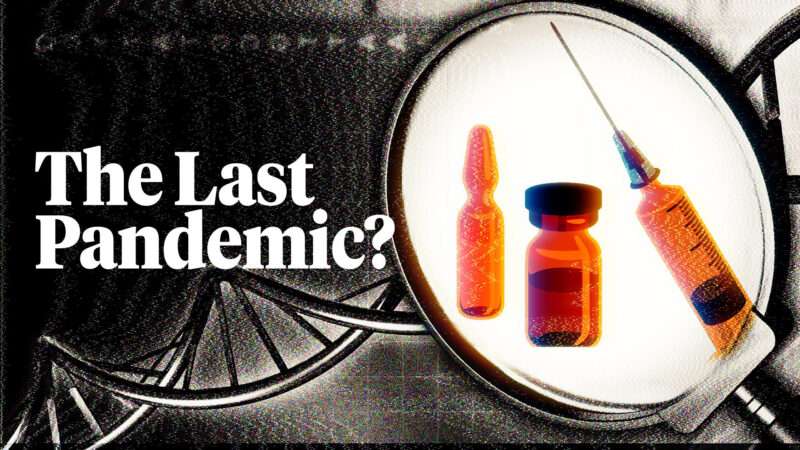
Since the novel coronavirus first showed up in America in January 2020, the U.S. government has routinely impeded scientists, public health officials, and citizens from coping with the COVID-19 pandemic. Early on, the surgeon general admonished Americans for buying masks. As late as last August, the Centers for Disease Control and Prevention (CDC) was downplaying broad-based testing among asymptomatic people. It wasn’t until this April—more than a year into the pandemic—that the agency finally acknowledged what had become clear only a few months in: COVID-19 is rarely spread by surface contact. It’s primarily an airborne disease.
The Food and Drug Administration (FDA) stood in the way as independent labs worked to quickly develop COVID-19 tests that would allow individuals to know if they were infected and should self-quarantine, and it wasn’t until this spring that the agency finally approved an at-home test you could get without a prescription. The FDA also temporarily pulled Johnson & Johnson’s vaccine from the U.S. market because one out of every 1.13 million recipients developed blood clots. Those are the same odds of being struck by lightning.
The one clear policy victory—Operation Warp Speed, which promised payments to developers of coronavirus vaccines—was based on biomedical innovations such as “messenger RNA” vaccines—that were already underway before the novel coronavirus appeared. “The horrors of the last year have spurred humanity to quickly develop an unprecedentedly flexible and powerful toolkit that may well make COVID-19 the last true pandemic,” writes Reason Science Correspondent Ronald Bailey in the May cover story for the magazine.
“The amazing thing is that we’ll be able to forestall any further pandemics in the future because so many great advancements in vaccine treatments…have come out of that,” he tells Reason TV. “Now you can just slip any piece of genetic information into that lipid and now you have a vaccine.”
Safe and effective COVID-19 vaccines were produced far faster than any expert expected. Yet almost all of the time that it took to bring the vaccines to market was due to safety testing and other governmental mandates that could have been sped up without endangering anyone. By January 13, 2020—only two days after the Chinese researchers shared the genetic sequence of the COVID-19 virus and before most Americans had heard of the disease—the biotech company Moderna had devised the formula for its vaccine. BioNTech launched its COVID-19 vaccine program in January and had partnered with Pfizer to manufacture it by mid-March of last year. The first volunteer was injected with Moderna’s vaccine on March 16, 2020, yet it was only approved by the FDA last December 17th, a week after Pfizer’s vaccine met the agency’s approval. Had the agency been faster off the mark and used human-challenge trials and other innovative testing techniques, the vaccines could have been brought to market months earlier with no compromise in safety. That would have conceivably saved hundreds of thousands of lives globally.
Bailey stresses that mRNA vaccines represent a whole new way of fighting diseases. “It’s a platform vaccine,” he says. “If we have another microbe, virus, or bacteria, we’ll be able to quickly identify its genetics and just plug it into the particles that are the base of the vaccine and roll it out within three to four months as opposed to a year.”
mRNA vaccines are currently in human trials for HIV, rabies, and influenza. They may also prove effective against malaria, tuberculosis, hepatitis B, and cystic fibrosis. A team of colorectal cancer experts are testing the mRNA technology in a Phase II clinical trial as a possible cancer treatment.
Will our government allow a vaccine based on this plug-and-play model to be deployed not within months, but in a matter of weeks, to stop the next pandemic in its tracks? “My answer is to let us deploy the technologies as quickly as possible, and then we won’t have to make any of these trade-offs ever again,” says Bailey. “If we have another pandemic and another failure [like with COVID-19], it will be a policy failure. Our bureaucracies need to get out of the way and let vaccines be deployed in an expeditious way.”
Produced by Noor Greene; additional graphics by Isaac Reese; audio by Ian Keyser; narrated by Nick Gillespie.
Animation: Scientific Animations/scientificanimations.com; Abbott Laboratories.
Music: Pave the way by Lux Inspira via Artlist.
Photos: ZUMA Press/Newscom ID 807358,140221 ©; Polaris Images ID 784557-784557© /Newscom; Reuters Photo Archive ID 181417 © /Newscom; Splash News ID 194588 © /Newscom. Twenty 20 Photos/Envato; ID 22740662 © Andreus | Dreamstime.com; ID 60394307© Incomible| Dreamstime.com.
from Latest – Reason.com https://ift.tt/2RvqRbE
via IFTTT